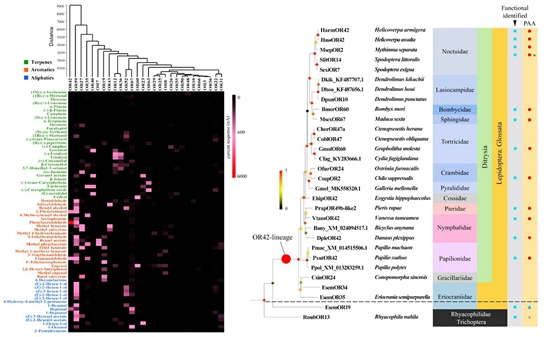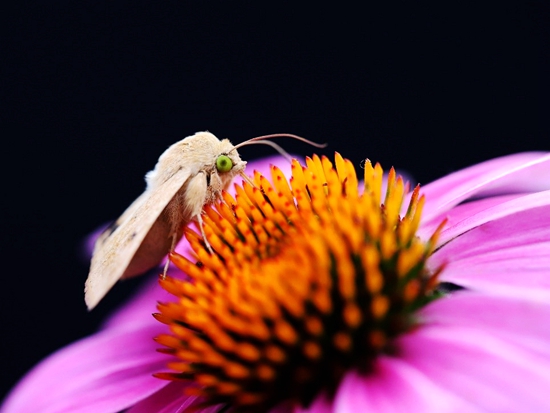IPPCAAS Scientists Reveal a New Mechanism of Co-evolution between Lepidopteran Insects and Angiosperms
Recently, a research paper titled “Odorant receptors for detecting flowering plant cues are functionally conserved across moths and butterflies” has been published online in the journal Molecular Biology and Evolution by researchers from the Innovation Team for Development and Application of Biological Insecticides of IPPCAAS. This study systematically reports the global function of the odorant receptor (OR) family in the major agricultural pest cotton bollworm Helicoverpa armigera, and reveals a new mechanism of olfactory mediated co-evolution between lepidopteran insects and angiosperms.
Lepidoptera, which include both moth and butterfly species, represent a critical insect order in the entire terrestrial ecosystem. The herbivorous larvae of most lepidopteran insects can cause damage on various crops, and the pollinated adults feed on nectar to replenish their nutrition. Plants release complex volatiles as they grow, on the other hand, lepidopteran insects evolved highly sensitive and specific olfactory system for combinatorial coding all kinds of plant volatiles to find a host for feeding and spawning during co-evolution with plants. However, little is known about the molecular mechanism of how herbivores recognize host plant volatiles.
In this paper, Prof. Wang Guirong and co-workers systematically studied the function of OR family of the major agricultural pest H. armigera, and generated the functional map of HarmORs for coding complex host plant volatiles by a combinatorial manner, which answered the question that why lepidoptera pests can sense thousands of odor molecules with only a few dozen ORs. On this basis, further findings demonstrated that receptors for sensing floral scent from host plants are functional conserved among lepidopteran species. This study also suggests that such kind of receptor emerged along with tube-like proboscis of lepidoptera insects at the time when angiosperms blossom. This work deepens our insight into the co-evolution between insects and angiosperms, also provides crucial molecular targets toward developing eco-friendly prevention and control technology for pest behavior regulation.
This study was supported by grants from the National Natural Science Foundation of China and Science and the Agricultural Science and Technology Innovation Program (ASTIP) of CAAS.
More details can be found at the link below:
https://academic.oup.com/mbe/advance-article-abstract/doi/10.1093/molbev/msaa300/5999809


By Liu Yang (liuyang02@caas.cn)
-
 Apr 18, 2024Opening Ceremony of the Training Workshop on Wheat Head Scab Resistance Breeding and Pest Control in Africa Held in CAAS
Apr 18, 2024Opening Ceremony of the Training Workshop on Wheat Head Scab Resistance Breeding and Pest Control in Africa Held in CAAS -
 Apr 03, 2024IPPCAAS Co-organized the Training Workshop on Management and Application of Biopesticides in Nepal
Apr 03, 2024IPPCAAS Co-organized the Training Workshop on Management and Application of Biopesticides in Nepal -
 Mar 28, 2024Delegation from the School of Agriculture and Food Science of University College Dublin, Ireland Visit to IAS, CAAS
Mar 28, 2024Delegation from the School of Agriculture and Food Science of University College Dublin, Ireland Visit to IAS, CAAS -
 Mar 25, 2024Director of World Food Prize Foundation visited GSCAAS
Mar 25, 2024Director of World Food Prize Foundation visited GSCAAS -
 Mar 20, 2024Institute of Crop Sciences (ICS) and Syngenta Group Global Seeds Advance Collaborative Research in the Seed Industry
Mar 20, 2024Institute of Crop Sciences (ICS) and Syngenta Group Global Seeds Advance Collaborative Research in the Seed Industry
